Interior Design in Restaurant Make Customer Come Back
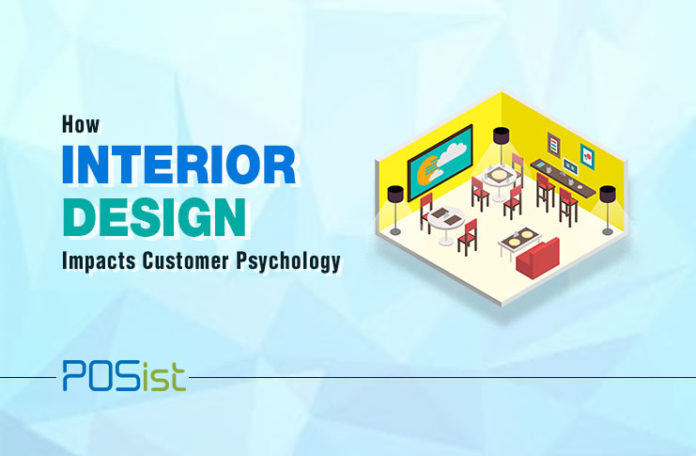
While restaurants, ice-cream parlors, cafes, and every other establishment in the F&B industry compete with each other using location, prices, and promotions, very little take the win from the margin of their interior design.Most people do not know this, but the restaurant interior design impacts customer psychology prompts them to order more or less, and even impacts the duration of their stay in the restaurant. Seating options, light, music, and architecture, all constitute a restaurant's interior design. Here is a guide on how you can influence your customer's psychology using interior design in restaurants and some brilliant restaurant interior ideas that you can use at your outlet.
Importance Of Interior Design In Restaurants
Restaurant interior design must be an essential part of your restaurant marketing strategy since the way your restaurant looks will be crucial to your branding. Your interior design is the first thing that your customer will notice as he/she walks through the doors. This first impression will dictate how they perceive your brand, what level of service they expect, what kind of time they anticipate, and if they want to come back again. Thus, the importance of interior design cannot be underplayed. Here are some reasons why restaurant interior design is so important:-
- Restaurant Interior design in restaurants is crucial to the branding strategy. The way a restaurant looks impacts how the customers perceive the restaurant concept and if they consider it a good enough place to eat at.
- Shabby or very bright interiors will form a negative impression on the customers and potentially make them leave even before they eat. An ideal restaurant interior idea would be to use natural light to its fullest to make sure your place is more Instagrammable.
- In the age of Instagram, interior design is your restaurant's silent salesman. Everybody wants to post where they have been all day, and if your restaurant looks Instagramable, it will make it to your customer's feed and entice their entire follower list.
- Good interior design means marketable interior design. You can use your interior design for marketing your restaurant among your target customers. If there is something unique about your interiors, make it public. People love to think that they are a part of something unique and would flock to your restaurant.
- Most importantly, interior design in restaurants impacts customer psychology. You can make your customers order more, eat fast, drink more, stay less, etc. all using interior restaurant ideas.
Now that you know why interior design in restaurants is so important, we come to the Impact of Interior Design on Customer Experience and Customer Psychology. To understand how six elements of interior design in restaurants can impact customer experience in such a significant manner, read ahead:-
Elements Of Restaurant Interior Design And How They Impact Customers
The primary aspects of a restaurant interior design include the following:-
- Architecture & Design
- Lighting
- Seating
- Colors
- Smell
- Acoustics
In this article, we will discuss all these elements and their impact on customer psychology and satisfaction.
1. Architecture And Design
The architecture and design are the essential aspects of restaurant interior design. The way you design the inside of your restaurant and place all your elements plays an integral role in defining the look and the feel of your restaurant. It also has a significant influence on customer experience because it includes planning the layout of your restaurant.
How spacious your restaurant will feel, how claustrophobic it will get during rush hours, and how comfortable it will be to walk around without bumping into people or crashing into tables, all of this is dependent on the restaurant layout. It makes no sense for your joint to be beautiful if your servers cannot serve well, and customers cannot feel comfortable in their own space.
The floor plan of your restaurant must be such that there is individual space for every person seated. If you are a fine dining restaurant, 20 sq feet area per seat is ideal; however, for a QSR 10 sq feet area is considered perfect.
Service stations though not in vogue these days, are best located where the customer footfall will be minimum, like the exact center of the restaurant. Install a service station or a reservation desk at the entrance only if it is big enough; otherwise, it will crown the door.
Make sure that your servers can see the customers, and your customers can see the servers at all times. The floor plan of the dining area must include space for operations. Leave enough isle gaps between your seats for proper service.
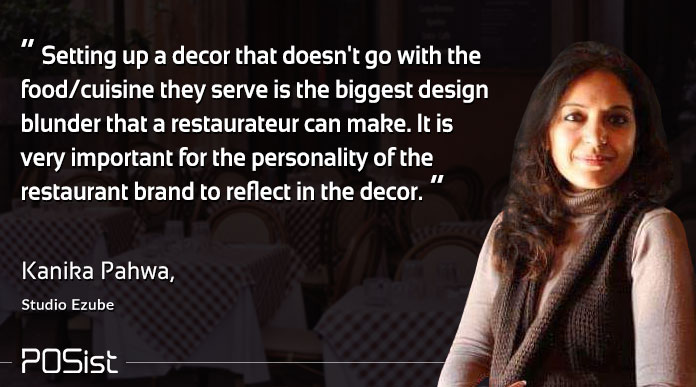
Restrooms must be located away from the kitchen but be visible still in your restaurant interior design. If it is behind a wall or somewhere towards the outside, make sure you put a direction board as not everyone is comfortable asking for directions. Play around with padded interiors, quirky wall hangings, or any other ideas you may have around this basic skeleton.
This article will serve as a Comprehensive Design Guide To Create A Restaurant Layout And Floor Plan.
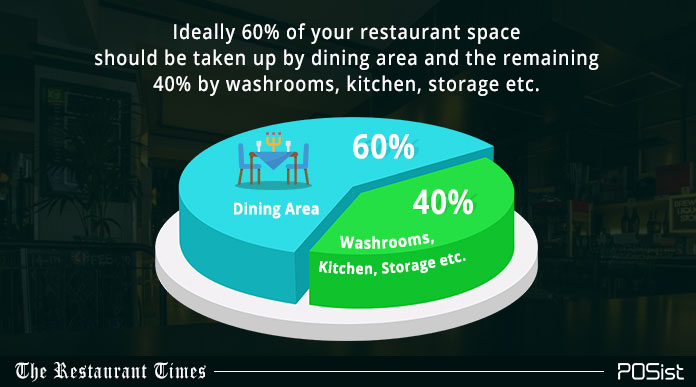
2. Lighting
Lighting is an essential part of your restaurant's interior design. It does not make any sense for you to have everything perfect if the light is so off that it kills the effect. Technically there are three types of lighting- Ambient, Task, and Accent lighting.
Ambien t lighting defines the overall look and feel of your restaurant. Is your restaurant dimly lit or is it bright and heavy on the lights, this is the light that defines it. Fine dining restaurants usually use dim ambient lighting to create a relaxing mood and aura. As they serve customers in a way that pushes them to linger, and so order more, this atmosphere is perfect. QSRs, on the other hand, must be well lit. The idea for them is for customers to come, eat fast and go. Bright lights induce that behavior, so the customers don't keep lingering around.
Task lighting is the light used for performing tasks. These are the lights that enable servers to work and customers to read the menu and order. This light is to be used strategically so that it does not kill the objective of the ambient light, but at the same time performs its function well, especially in fine dining restaurants. You can use it to highlight pathways or incorporate it by putting it on some unique features like sushi bars or minibars to highlight them.
Accent lights are lights used for that extra touch but mostly decorative purposes. There you can experiment with, but most wall lighting in this area is received better than overhead lighting. You can use these lights to reinforce the colors of your brand as well, but don't overdo it, or else it will kill the purpose.
As a restaurant owner and not an interior designer, you may feel that all these lights are just the same. True, there is not much of a difference between the three for the untrained eye, but if misused, the result can be nightmarish. This article will help you understand how ambient, task, and accent lighting differ from each other.
3. Seating
Seating is another unnoticed part of restaurant interior design. The type of seats you use impact your customer's psychology and the experience as well. Ever noticed how QSRs like McDonald's and Subway have seats that are comfortable but not exactly the type you would want to keep sitting on. At the same time, they give a very light feeling. All this impacts the customers to be fast eaters and not stay.
On the other hand, Starbucks has comfortable seats, recliners, and sofas that are heavy and cushioned. This prompts customers to stay longer and keep ordering more coffee. The same can be said for fine dining restaurants. Mixing alternate seating methods like swings or hammocks also have the same effect and prompt the customer to relax and stay. Swings, on the other hand, remind one of childhood and speed. This makes the customer sitting on it to order impulsively and eat fast.
4. Colors
Colors believe it or not play a huge role in your restaurant interior design. The main thing that impacts what colors you must use in your restaurant is your target clientele. Different colors trigger different emotions and set different moods. Some colors stimulate diet while others repress it. Warm colorslike red and orange are considered potent stimulants, and so a lot of restaurants try to use red in their interior.
At the same time, it is an intense color, so it is best not to go overboard with it. Yellow is a bright color and can bring out people's appetites by giving a lively feeling to the place. Blue, on the other hand, is a suppressant. The reason why blue is considered a suppressant is that it relaxes the diners and calms them; hence they order less.
Fine dining restaurants aim for a mood where customers would want to linger as opposed to QSRs and so it makes colors like blue or turquoise ideal for them. QSRs, on the other hand, need customers to order more and eat fast, thus making warm shades suitable for them.
Check what interior color suits your restaurant format and designs to make better sales overall.
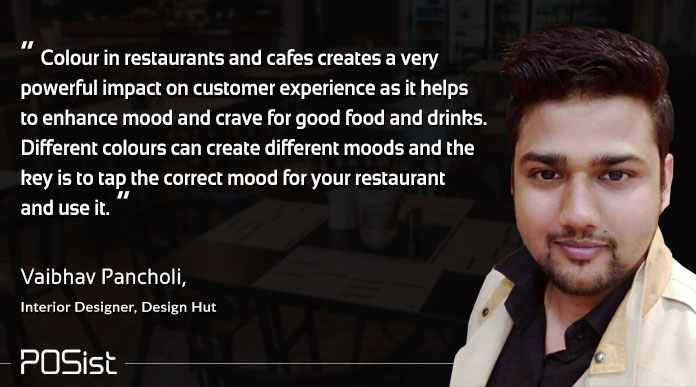
Then there are shades which are big no-nos. Gray, brown, and purple come in this category. While grey is dreary and tired, brown reminds one of burnt food, and purple is associated with less popular foods like eggplants or brinjals.
5. Scent
Believe it or not, scent marketing is a thing. Think about what happens when you pass by Wengers, Cinnabon, or Starbucks. The smell of their products overpowers you and stimulates you to walk into the store. This may sound far-fetched, but according to a study, the right scents can increase your food sales by 300%, so make sure you include it in your restaurant interior design. In fact, according to the University of Paderborn, scents increased impulse buying by 6%, buying intention by 14.8%, and the length of a customer's stay by 15.9%.
Letting some smells float in from the kitchen can induce appetite. You can either go for an open kitchen for this or even manage ventilation in this manner. Another thing that you can do is go for artificial scents. Just like colors, different scents create different emotions in people.
Chamomile, Lavender, and Vanilla reduces stress and relaxes the mind making them perfect for a fine dining restaurant. Baked bread reminds one of home and gives a comforting feeling, thus works well for the dessert section of a restaurant or a bakery. Peppermint, cucumber, and citrus flavors make a person feel fresh, making them ideal for restaurants catering to after-work corporate employees. Allowing scents to build up in a cloche fills it with the aroma of good food. Now, as the lid is removed, customers are hit with the same scent, which increases their appetite. It also makes other diners want to order more. The smell of cucumber can make the customers feel that an area is more significant than it seems, which makes it perfect for small spaced establishments.
Depending on the type of vibe and the customer experience you want to create in your restaurant, you can choose from a variety of smells. Just remember never to use barbecue as your scent, even if you run a barbeque joint. It makes the place feel small and more stuffy while killing the appetite.
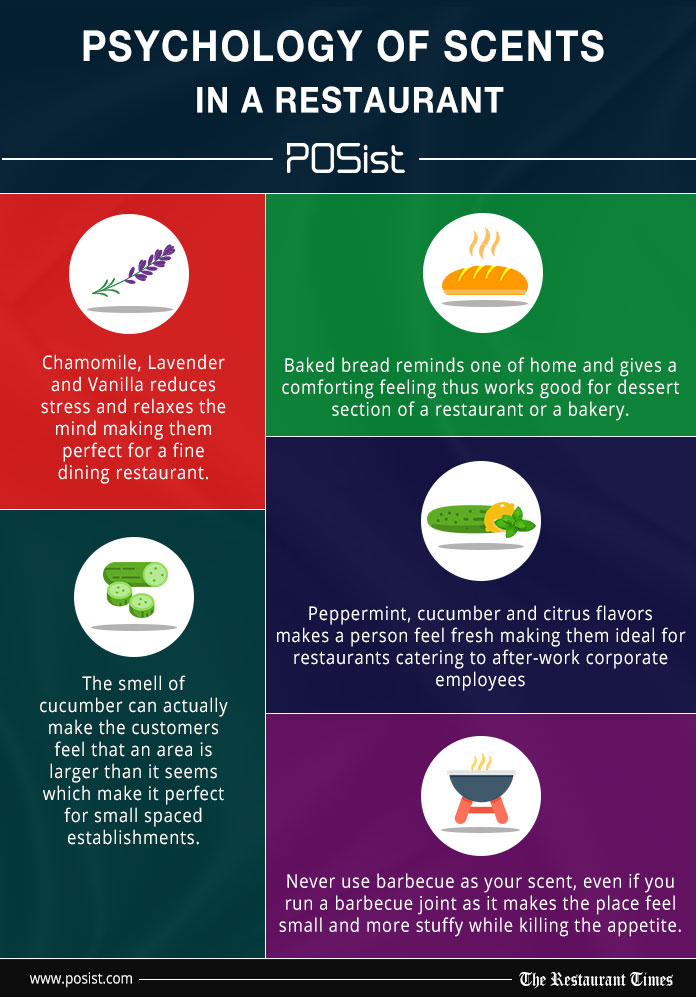
6. Acoustics
Lastly, we come to acoustics. You may think that music or choice of it is not necessarily important, but that is the most incorrect conception you could have. Music does more than just fill the gaps in a restaurant. First, we come to the volume of it. Controlling the volume at which you will play the music is the trickiest thing to do. While too loud can create noise, too soft can make people think that other diners can hear them and so make them awkward. We advise that you use acoustic control techniques like false ceilings, carpets, or curtains.
Now coming to the type of music, that also depends on your clientele. For a high-end restaurant, instrumental works best. Having a live piano is the best thing you can do if you run a fine dining restaurant. For restaurants that are not exactly fine dining but not QSR's as well popular, trending music is the right choice. Use faster beats for rush hour and relaxed, slow tempo beats for off-hours.
Read this article on how to choose the right background music for your restaurant.
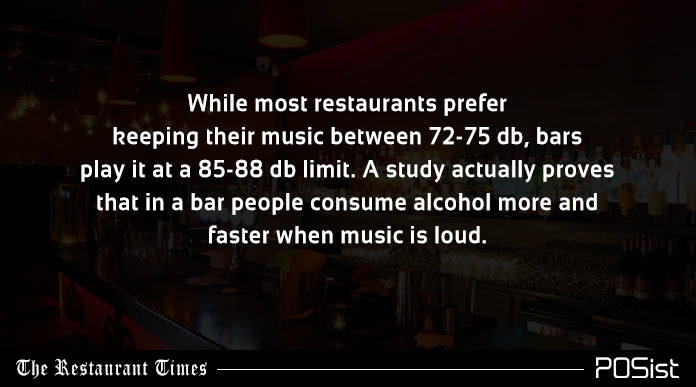
More than half of marketing is understanding your customer's psychology and taking advantage of it to get what you want. Employ these tips in your restaurant interior design to make sure that you leave a desirable impact on your customers and make them come again and again.
Rating: 5.0/5. From 9 votes.
Please wait...
Interior Design in Restaurant Make Customer Come Back
Source: https://www.posist.com/restaurant-times/resources/importance-of-restaurant-interior-design.html